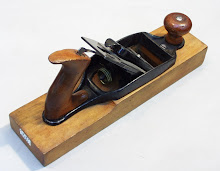
Using some 3/4"x3"x6' pine, I created a frame by centering and bolting them to each side being sure that the were flush to the top of the table and centered on the middle bolt hole on both sides.
I left several inches of space between the saw table and both table extensions to allow the blade guard and rip fence to function. The fence is a tight squeeze, but it works fine. for different saws you will have to play it by trial and error. In my case I measured off some space and used masking tape between the side beams to ensure I had enough clearance.
To that measurement I added the width of the table extensions (15-1/4") and the thickness of the end board - 3/4". I then subtracted 1/4" because I wanted to cut a rabbet for the table extensions to sit in and help keep them from sagging.
I unbolted both side pieces and made the cuts for length and cut 1/4" dado's in the ends to receive the end pieces to the frame. Then I cut the end pieces to fit and clamped all 4 together to check that I had cut everything square and they fit well. As it's often said, "Measure twice and cut once since we're all out of board stretchers."
Since everything fit and I was able to square the frame up with a framing square inside the clamps, I began cutting the rabbets. first, 3/4" deep using the rip fence and another board clamped to the saw table to keep the boards from moving. Then I cut them all to a depth of 1/4" and chiseled out the corners where the saw couldn't cut through.
Finally, I cut the table extensions to size. These came from the lumber store marked as shelves. I don't drive an SUV or pick-up to save gas money so I have to get my lumber in manageable pieces that fit in the car with the back seats down.
With the table all cut and dry fit, I drilled pilot holes and screwed everything together and bolted it to the saw. Here's the photo:

Here is another view from on top of a 6' ladder right above it:

Next, I thought legs in the corners would be great, so I took an 8' 2"x4" with few knots in it, and ripped it down into (2) 1-1/4"x8' boards. Using a 4' level (a 2' would work as well) I lifted the table until it was level and measured from the ground to the bottom of the frame. This 36" height worked well because I in my box of hardware last weekend, I had 4 bolts and t-nuts to use as feet. A t-nut is like a thin walled nut with a washer on the end which can be pounded into a hole so a bolt can be screwed in. Here is a link to what they look like.
I drilled the holes in the ends of the legs, pounded in the t-nuts and screwed in the bolts. Finally I lifted the legs up to the bottom of the table deck (the MDF shelf boards) and screwed the legs to the corners of the table top with wood screws on both the side and end pieces of the frame. Using the level, I was able to level the entire table by adjusting the bolts in the t-nuts.
Here is what the whole thing looks like now:

When I get to discussing routers, bits and how to get the most out of them, I'll cut the slot into the table deck additions for the miter gage.
At some point I should add some spreaders to the legs, but for the moment this will work for what I'm doing and I have other projects to work on.
Next up: Lumber - Where to get it cheap or free and storage in the shop.












